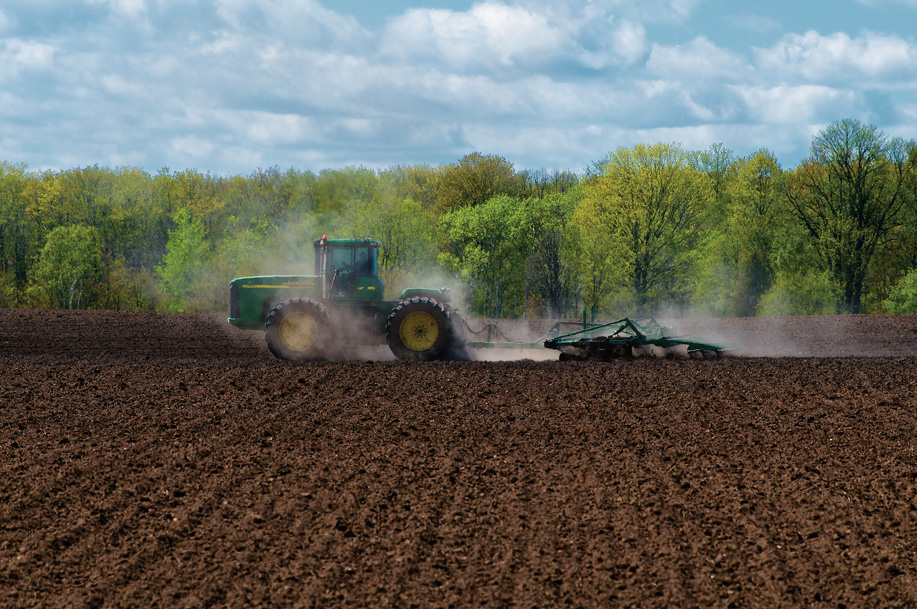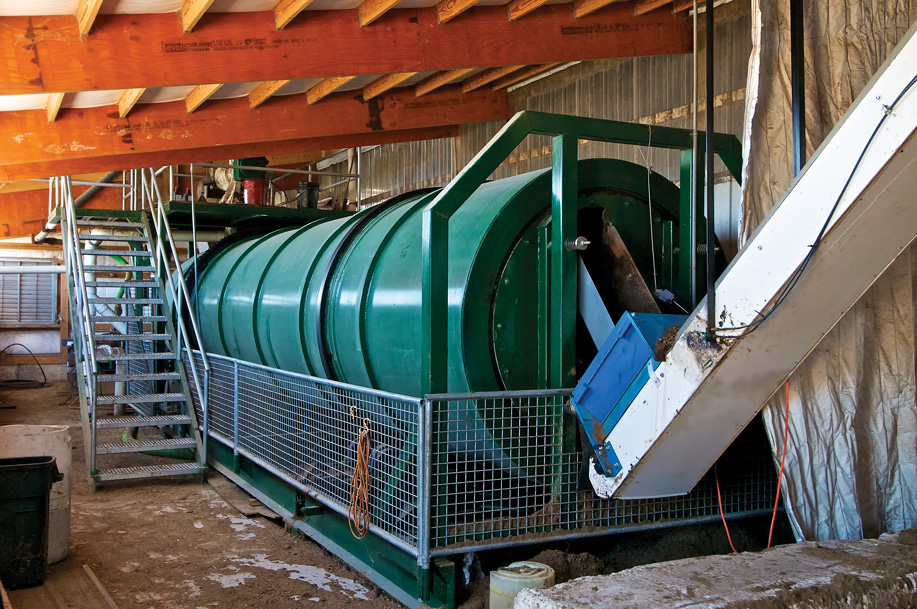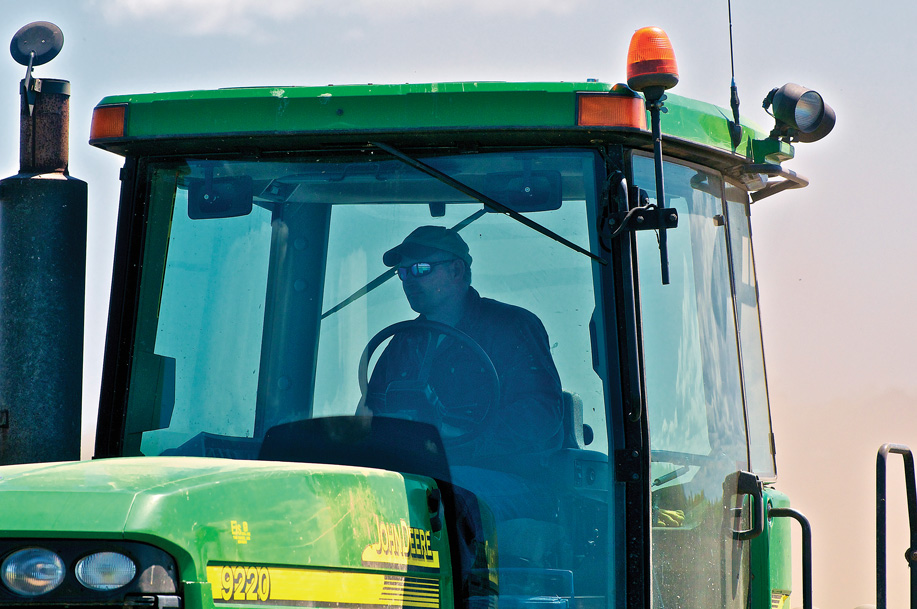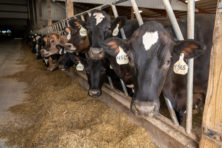Gilbert Family Farm Meets Big Business
- Share
- Tweet
- Pin
- Share

I lie to myself.
When I buy milk, or an ice cream cone, or a hamburger at the pub, I like to imagine the picture of a Holstein in a pasture flanked by stone fences, happily grazing from the lush green grass of Wisconsin. I like to picture this cow basking in the summer sun before retiring for the night into a freshly painted red barn with a few dozen of her Holstein friends. That’s what I like to think.
As I said, I lie to myself.
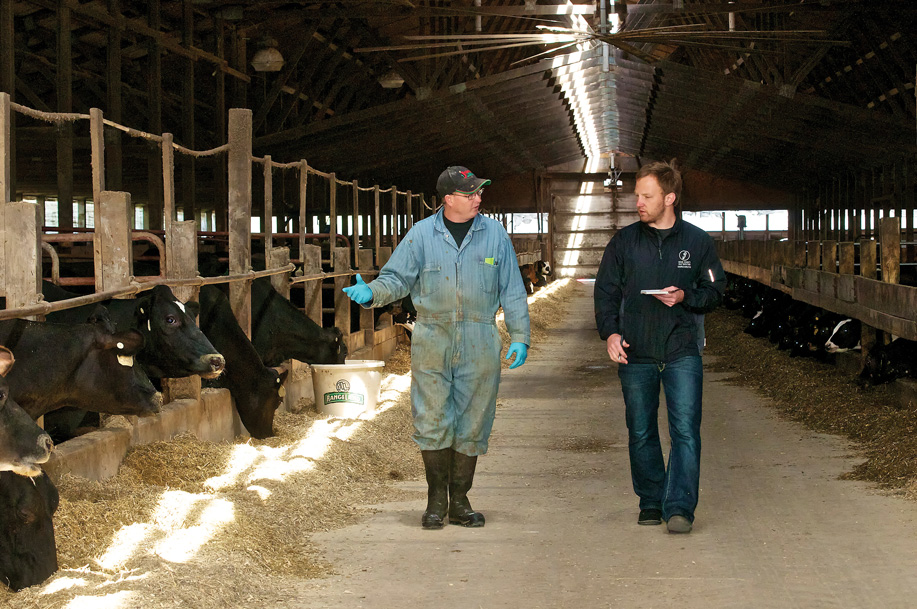
Myles Dannhausen Jr. (right) tours the Gilbert Family Farm with Tim Gilbert. Photo by Len Villano.
I meet Tim Gilbert in the calf barn at the farm he owns with his older brother Ron on county Highway T in Sevastopol, about three miles outside of Sturgeon Bay. It’s 10:00 am and he is already several hours into another long day, but he’s in good spirits. He likes the farming life and the dedication it requires. I raise my arm to shake his hand, but his look tells me that shaking his hand, covered in a rubber glove smeared by a morning in the cow barn, is not in my best interests. I agree.
Tim is clad in a muddied one-piece denim work uniform that billows like an old Brooklyn Dodgers baseball uniform, tucked into the black rubber boots that rise above his calves. He watches his cows through wire-rimmed glasses under a Jung Seed Genetics ball cap.
If you heard Tim speak only a couple of sentences, you could easily mistake his voice for nervous, peppered as it is with a pitchy crackle. But he’s at home here in the barns, where he has been breeding cows for 35 years, and he dives into the science of tweaking the cows over generations through crossbreeding to create a cow that produces high quantity milk with the right combination of components – milk-fat and protein – that buyers like BelGioioso Cheese are seeking. You get better cheese with more fat and proteins, he says, something dairy farmers didn’t pay much attention to decades ago.
“You get paid more for better components,” Tim says. “You get less milk, but it’s better for cheese.” That’s where most Wisconsin milk goes, not into the milk we drink and pour on our cereal, but into cheese.
Tim takes me into the main barn, a massive free-stall barn that holds 200 cows. He explains more of his breeding process and how he breeds for more visual characteristics as well as the components.
“You may see one cow and decide the udder is too low,” he explains. “Well, you can fix that with the next generation. You just take the bull that throws a cow with a tighter utter. Genetics are so huge, that’s why cows have progressed so much in terms of the output they can produce.”
The process is more scientific and far less “small-town farm” than we might think exists on the peninsula.
The Gilbert Farm, in fact, is an evolutionary crossroads of the misperceptions and moral dilemmas consumers have about the American food system. The Gilberts operate a total confinement operation. It falls short of qualifying as a large Concentrated Animal Feeding Operation, or CAFO, the term for farms of 1,000 or more animal units. (Animal units are determined by weight, so 700 milking cows equal 1,000 units, but 10,000 sheep equal 1,000 animal units). The acronym, CAFO, has become a four-letter word to opponents of large-scale agricultural practices. To them, confinement operations are the epitome of what is wrong with American agriculture and represent the reason for the disappearance of yesteryear’s rural lifestyle. To be honest, it’s precisely the kind of operation that I’m inclined to dislike.
The 1,200 cows on the Gilbert Farm will spend their entire life in the barns. They will rarely walk on grass or soil. They will sleep in stalls, their food will be brought to them on a tractor, and they will spend their lives on concrete.
Tim actually takes this into consideration in his breeding practices, crossbreeding to create a cow that can withstand a life on concrete. Holsteins are getting bigger and bigger, he says, leading to hoof and joint problems. He breeds a mix of Holstein and Jersey cows “because they’re lighter and can hold up better on concrete.”
I bristle at the thought, but I know I’m a hypocrite. I buy local when I can, and I look for free-range or grass-fed products when my budget allows, but I’m not steadfast. When I eat out, I’m sure that most of my meat and dairy comes from farms just like this, or much larger.
Farms of 200 cattle or more, which are almost exclusively confinement operations, were responsible for 44 percent of the state’s dairy production in the U.S. Department of Agriculture’s 2007 census. When the next survey is taken at the end of this year, that number is expected to rise significantly. In California, such large operations represent 99.2 percent of the state’s milk production.
The Gilberts have a large operation, but it’s dwarfed even by several in Kewaunee County, where there are 15 permitted CAFOs. Door County has just one.
The cows feeding before me look healthy, clean. In the summer the barn’s shelter and a built-in mister keeps the cows cool. The ventilation provided by a bank of fans on each end of the barn keeps flies, a constant nuisance that stresses cows, off their backs without using chemicals.
Years of studying cattle health and milk production has led to dramatic improvements in bedding, waste management, and stall design. Twenty-five years ago the stalls in free-stall barns were barely wide enough for the cow to squeeze into. Some farmers even tied their cows to the stall. Not here. The stalls are wider and the cattle are free to roam within the barn, to feed as much as they want, and to lie in stalls where the Gilbert’s have installed mattresses to improve comfort. Those mattresses are supplemented with bedding composed of recycled dry manure made daily by a massive manure composter.
As a result, the cows spend more time laying down, have fewer joint and hoof problems, and fewer cases of mastitis, an infection of the udder often caused by cows laying in dirty or bacteria-ridden bedding. Cow comfort, even in a confined operation, is paramount if a farmer wants productive cows. Tim’s mother, Margaret, said her late husband instilled a mantra into his sons.
“The thing that makes money on the farm is the milk in the tank,” Margaret remembered him saying often. “And if you take care of the cows, you get the milk in the tank.”
I watch a large cow step over a chain as it lurches along the floor. The chain moves all day, pulling an alley scraper to clear the manure from the barn, into a pit, and into the manure composter. From there, the left over liquid manure goes into two mammoth concrete manure pits behind the barns.
The system keeps the barn surprisingly clean, but it’s costly. Tim estimates that they have something close to a million dollars invested in their waste management system, but it brings benefits.
“Years ago it was every day you went out and spread manure and pissed off all your neighbors because of the smell,” he says. “Now it’s two weeks and you’re done. It’s easier today.”
Tim doesn’t entirely dismiss the concerns of those, like me, who recoil at the thought of a cow never leaving the barn. He says he’d like to pasture his cows, but argues that life in the barn isn’t so different from life on the pasture.
“Look at a cow in the pasture,” he tells me. “What are they doing? They’re standing around, huddled together. Here they do the sa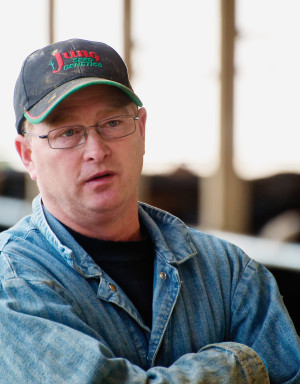 me thing, you’re just bringing the feed to them. The nice thing here is they don’t have to go through those brutal summers and the flies eating at ‘em for six months out of the year.”
me thing, you’re just bringing the feed to them. The nice thing here is they don’t have to go through those brutal summers and the flies eating at ‘em for six months out of the year.”
Veterinarian Paul Haas, co-owner of Door County Veterinarian Associates, says what people often see as ideal isn’t what’s best for the animals.
“Everyone has this idealized picture of cows in pasture,” Haas says. “Those are open fields with no shade. Flies are not a lot of fun for these cattle. In a lot of cases, these barns are better than cattle being out on pasture. Certain times of the year that’s true. There are a lot of advantages to some of these barns.”
Haas calls the Gilbert Farm “one of the better run farms in the county. You don’t see very many fat or very skinny cattle. Don’t see them limping or lame. That tells you they’re healthy.”
A Tale of Two Farms
For a take on another farmer’s approach to the dairy farm you don’t have to go far. Just down the road lives a farmer who operated a grass-fed dairy for 21 years before he sold his herd last winter. His name is Mark Gilbert, Tim and Ron’s brother.
Mark, 54, considered partnering with his brothers, then thought about starting his own confinement operation, but the bank turned down his loan request. Years later he thanked the loan officer for turning him down.
Mark studied up on the New Zealand style of dairy farming and discovered it has the lowest cost to produce milk in the world. He felt it was better for the animals, but his primary concern was evaluating it from an investment perspective, he says.
Running a small grass-fed dairy – Mark had 125 cows – required less investment up front and less labor to maintain.
“The cattle are doing a lot of the work for you,” Mark says. “They harvest their own feed. The manure they make is put right out there and recycled so there’s no manure to haul.”
He built the swing parlor for milking the cows himself, using skills he learned working in the shipyards. The parlor cost him $20,000 to build, rather than today’s going rate of several hundred thousand dollars.
Though Tim Gilbert’s cows are healthy and productive, they only produce at peak levels for five to seven years before they’re sent to the butcher. Mark Gilbert’s cows, meanwhile, produced past 10 years old and as long as 15.
He says that if more farmers followed his example they could survive on smaller farms.
“If I were going into it today I would definitely go the organic route,” Mark says. “It was good to us over the years. It allowed me to get out of it earlier.”
Haas says the animals on both farms are extremely healthy and that one method isn’t better than the other.
“They both are profitable farms, but with opposite styles,” he says. “We didn’t see very many sick cows there. Both of them work. It just depends on how you want to farm. From a health standpoint, a lot has to do with the people and how they keep an eye on the farm. It’s not so much the size of the farm that impacts the health of the herd. It has more to do with the individual that’s running the place. Like any business, there’s well-run businesses and not-so-well-run businesses.”
Dr. Robert Kropp, an agricultural economist, dairy expert, and Professor Emeritus at the University of Wisconsin – Madison, says criticisms of modern farming methods are unfounded, emphasizing, as many in the industry do when practices are questioned, that the world depends on American farmers to produce more cheap food every year.
“These cows, if they were not treated properly, they would not produce 30,000 gallons of milk in a year,” Kropp says. “Some of this stuff is not based very much in science. By 2050 we need to increase food production in the world by 70 percent. We can’t do that with small, organic farms.”
The Pressure to Grow
Tim Gilbert grew up as one of 10 children working their father’s farm, where the cows were pastured until the 1980s on land in an area the Gilbert family has been farming for nearly a century. The path to the present hasn’t been a smooth one.
When Tim’s own father decided to farm he struggled.
“Grandpa told my dad he had to do it on his own, and he had a tough go,” Tim says. “He had a hard time borrowing money.”
His dad, Bruce, went bankrupt on his first farm, then started the current Gilbert Farm with one barn and 10 cows. An aerial photo of the farm from 1950 displays a reflection of our American farming ideal – an old wooden barn with a muddied pen to the west, orchards surrounding the property. It’s the picture we like to imagine when we grab our conveniently packaged ground beef at the grocery store, wrapped in food-service film on a blue or yellow Styrofoam tray.
“We had cattle out for as long as we could keep them out,” says Tim’s mother Margaret. Then the state enacted rules that forced farms to put in manure storage facilities to keep runoff from polluting lakes, streams and groundwater. Margaret says they had to build a $189,000 manure pit and that, combined with the pressure of so many children starting families of their own, meant the Gilbert Farm had to grow to support them.
“If you get bigger, it’s easier to handle the cows in the more convenient method and makes the manure storage facility more economical,” Margaret says.
Ron’s wife, Mary Gilbert, says a lot of farmers sold out because they couldn’t find that balance.
“You are either small enough to be self-sufficient and support your family, or you grow big enough to hire some people and get the income to support all the stuff you have to do,” Mary says.
Though the Gilbert farm seems large, it’s still dependent on the family. Tim handles the cows and lives steps away from the milk parlor with his wife Margaret, while his brother Ron is in charge of the crops and handles a lot of the equipment maintenance. Ron’s wife Mary does the books when she’s not working her primary job at Pinkert Law Firm, and their son, Dan, comes home from the University of Wisconsin – Stevens Point to help in the summers. Meanwhile Tim’s sons Wade and Ryan recently returned home to work on the farm as well.
They have one invaluable full-time employee, Alberto Sanchez, and they have some part-time help, but it remains a family operation.
“A big misconception is that these farms are corporate,” Tim says. “They’re still family farms, it’s just that you have to form a corporation or you wouldn’t ever make it.”
Balancing Nostalgia with Reality
We wax nostalgic about the loss of the small family farm, about the way of life it provided and the symbolism of a simpler time. But most of us who yearn for those days never worked on those farms or lived that life. Margaret regaled me for nearly three hours with touching, humbling stories of her life growing up on a farm before she attended the Algoma Teacher’s College and taught at Sugar Creek School.
She has lived her entire life within a mile and a half of where she lives now, enjoying a retirement career as a talented watercolor artist. She appreciates the work ethic and values she learned growing up on the farm, but she doesn’t let that gloss over a more prominent memory.
Margaret was one of six children. Her younger sister died at age five of spinal meningitis. A brother she was close to was killed working on a corn binder for a neighbor farmer when he was 15, and another died at age 40 when the hay he was raking in the barn’s haymow collapsed on top of him, suffocating him. Tim discovered him when he came home from school.
She and her husband lost their first farm, and shortly after starting their second he had to take a job with Inland Steel Company sailing on the lakes to make money. Their youngest daughter died very young, then the barn burned down in 1983.
I ask Margaret what she thinks when she visits her sons’ farm today. Does she pine for the old days? Does she wish they could go back?
“No,” she answers without hesitation. “If you want to survive now, you have to use modern technology. You’d be out of business if you didn’t. You have to be ahead of the times when you’re farming. No, those days are gone. When you’re farming you look ahead, you don’t look back.
“It was a hard life,” she continued after a pause. “You didn’t pile up money farming. You didn’t get paid much for your milk. You worked just to survive, to put food on the table.”
I leave the Gilbert farm still wanting to see cows in the pasture, feeding on grass, but I understand why the industry is changing, why the barns are crumbling, and I understand that how one chooses to farm isn’t a simple choice. There are pressures far more complicated than the label I want to see on my ground beef.

